
Amphipoda is an order of malacostracan crustaceans with no carapace and generally with laterally compressed bodies. Amphipods range in size from 1 to 340 millimetres and are mostly detritivores or scavengers. There are more than 9,900 amphipod species so far described. They are mostly marine animals, but are found in almost all aquatic environments. Some 1,900 species live in fresh water, and the order also includes the terrestrial sandhoppers such as Talitrus saltator.

The Gulf of Papua is located in the southern coast region of New Guinea. It has a total surface area of 70,400 km2 (27,200 sq mi).
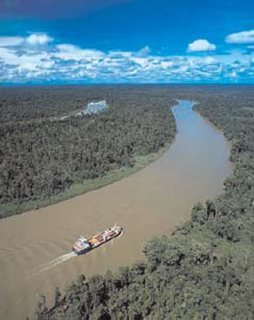
The Fly River is the third longest river in the island of New Guinea, after the Sepik River and Mamberamo River, with a total length of 1,060 km (660 mi) and the largest by volume of discharge in Oceania, the largest in the world without a single dam in its catchment, and overall the 20th-largest primary river in the world by discharge volume. It is located in the southwest of Papua New Guinea and Papua Province of Indonesia. It rises in the Victor Emanuel Range arm of the Star Mountains, and crosses the south-western lowlands before flowing into the Gulf of Papua in a large delta. The Fly-Strickland River system has a total length of 1,220 km (760 mi) making it the longest river system of an island in the world, including 824 km (512 mi) Strickland River is the longest and largest tributary of Fly River, making it the farthest distance source of the Fly River.

Geologically, the Sunda Shelf is a southeastern extension of the continental shelf of Mainland Southeast Asia. Major landmasses on the shelf include the Bali, Borneo, Java, Madura, and Sumatra, as well as their surrounding smaller islands. It covers an area of approximately 1.85 million km2. Sea depths over the shelf rarely exceed 50 metres and extensive areas are less than 20 metres resulting in strong bottom friction and strong tidal friction. Steep undersea gradients separate the Sunda Shelf from the Philippines, Sulawesi, and the Lesser Sunda Islands.
The Eucla Basin is an artesian depression located in Western Australia and South Australia. The onshore-offshore depression covers approximately 1,141,000 km² and slopes southward to an open bay known as the Great Australian Bight.
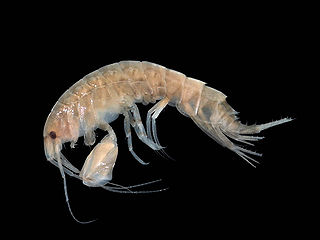
Melitidae is a family of amphipods. It contains around 45 genera, and formerly included a further 40 genera that are now placed in the family Maeridae.
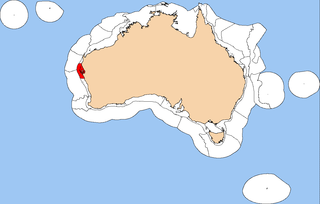
The Central Western Shelf Province, also known as the Shark Bay marine ecoregion, is a biogeographic region of Australia's continental shelf and coastal waters. It includes the subtropical coastal waters of Western Australia.

The Northwest Shelf Province, also known as Exmouth to Broome, is a biogeographic region of Australia's continental shelf.

The Northwest Shelf Transition, also known as Bonaparte Coast, is a biogeographic region of Australia's continental shelf. It adjoins the Kimberley region of Western Australia and the adjacent coast of the Northern Territory.

The Southwest Shelf Transition, also known as the Houtman marine ecoregion, is a biogeographic region of Australia's continental shelf and coastal waters. It includes the subtropical coastal waters of Southwest Australia.
New Guinea, lying within the tropics and with extensive mountain areas, comprises a wide range of ecoregions. These include rainforests, grasslands and mangrove.
Monellan Castle was a large castellated mansion on the southern outskirts of The Cross, a hamlet just outside Killygordon in the east of County Donegal in Ulster, the northern province in Ireland. It was constructed in the eighteenth century for the Delap family, an Ulster-Scots family who acquired the estate in the late eighteenth century. The family also owned estates in Buckinghamshire in England. The Monellan Burn, also known as the Creamery Burn, runs along the western and north-western edge of the former demesne surrounding Monellan Castle, flowing into the River Finn very near The Cross. The burn separated the Monellan Castle Demesne from the adjacent townland of Ballynaman.

Temperate Australasia is a biogeographic region of the Earth's seas, comprising the temperate and subtropical waters of Australia and New Zealand, including both the Indian Ocean and Pacific coasts of the continent and adjacent islands.

Maeridae is a family of marine amphipods, which was first described by Taudl Krapp-Schickel in 2008.
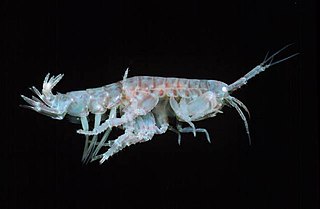
Ceradocus is a genus of amphipods in the family, Maeridae, and was first described in 1853 by Achille Costa. The type species is Ceradocus orchestiipes.
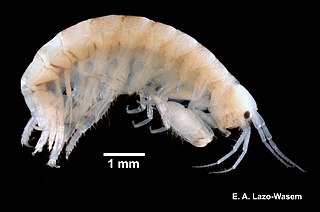
Elasmopus is a cosmopolitan genus of amphipods in the family, Maeridae, and was first described in 1853 by Achille Costa. The type species is Elasmopus rapaxCosta, 1853.
Elasmopus arafura is a marine species of amphipod in the family, Maeridae, and was first described in 2011 by Lauren E. Hughes and James K. Lowry.
Elasmopus arrawarra is a marine species of amphipod in the family, Maeridae, and was first described in 2006 by Lauren E. Hughes and James K. Lowry.
Elasmopus arafura is a marine species of amphipod in the family, Maeridae, and was first described in 2011 by Lauren E. Hughes and James K. Lowry, from a specimen collected at "The Blow-holes", Point Quobba on an exposed intertidal rock shelf.













